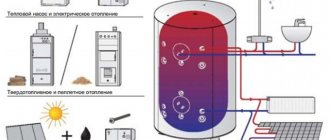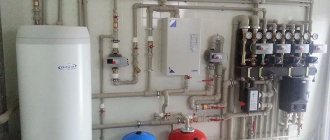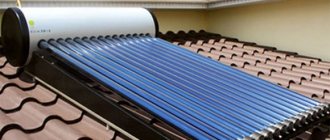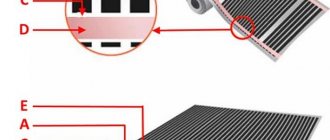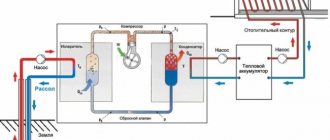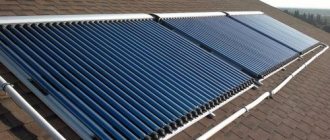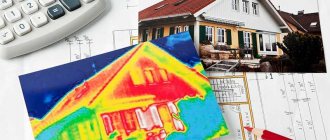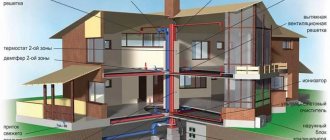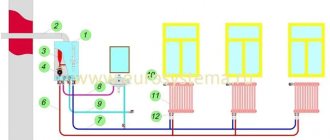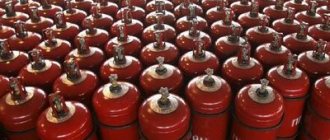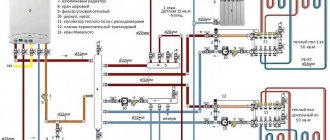Semiconductor panels that convert solar energy into electricity are usually installed for one purpose - to power home appliances. Real enthusiasts do not stop there and try to adapt solar panels for heating their home. We invite you to discuss this idea and consider possible methods of heating using photovoltaic panels. There is no point in discussing the profitability of alternative energy power plants and other financial issues; this is a separate topic.
Solar heating
The constant increase in tariffs and the dilapidated state of communications are forcing owners of private houses to actively look for alternative heating methods. One of the powerful and inexhaustible sources is the Sun, which supplies a huge amount of kilowatts of free energy every day. With the right hardware installed , dependence on network resource providers will become a thing of the past.
Solar energy is always available, although it depends on weather conditions or time of day. For regions where climatic and weather conditions allow obtaining a sufficient number of kilowatts for heating , this option becomes optimal. Solar heating provides a lot of opportunities and advantages that should be discussed in more detail.
The future belongs to alternative energy sources
Energy demand is growing in proportion to the speed of technology development. If today alternative energy sources are exotic and are used only where no other methods are suitable, then after some time the situation will change radically. Dependence on resource supply companies is not the most promising prospect, forcing us to look for other, more independent options for providing housing with energy and heat .
As soon as cheaper and more efficient equipment becomes available, the use of solar panels will become widespread
. The impetus for this will be overpopulation in the central regions, lack of housing and work, and the need to resettle in more remote regions. If by that time the equipment parameters become quite stable, and prices drop to affordable levels, then the demand for solar panels will become very high.
Design and principle of operation
Solar heating of a private home is an innovative technology that not everyone has a clear understanding of yet. Meanwhile, almost any homeowner has all the possibilities for installing and using the appropriate complexes. The need for financial investments exists only to purchase equipment or equipment; he will receive everything else for free.
There are two options for organizing solar heating:
- Solar panels;
- Solar collectors.
Using solar panels is a more expensive method that requires a large amount of equipment . Photovoltaic elements are used, located in an open area at the desired angle for maximum perpendicular incidence of sunlight. They generate electric current , which is accumulated in batteries , converted into alternating current with standard parameters, and then sent to heating devices.
Heating from solar panels in a private home provides a lot of additional opportunities. This method has a significant advantage - the electric current generated by solar panels can be used not only to heat the house, but also to power any devices , for lighting or other needs.
Solar panels for home heating, the cost of which is quite high, may not be financially viable.
Solar collectors operate on a different principle. They do not produce, but receive thermal energy from the Sun , which heats the coolant in containers or tubes. In principle, any container of water exposed to the sun can be considered a collector, but there are special designs that can demonstrate the greatest efficiency. This version of the system is much simpler, cheaper and available for self-production .
The resulting heat is immediately realized in increasing the temperature of the coolant, which is accumulated in a storage tank, from where it is distributed throughout the heating circuits of the house. The optimal heating method is to use low-temperature systems such as underfloor heating. They do not require strong heating, which corresponds to the capabilities of solar collectors. At night, the coolant heated during the day is consumed.
For maximum efficiency of solar collectors, it is necessary to properly insulate the storage tank.
How it works?
Solar cell cells are made of silicon wafers. When photons of light hit the crystal lattice of this material, some of the electrons begin to move. And from the school physics course we know that the movement of electrons in a conductor is electricity.
The total energy emitted by the sun in all directions is approximately 385 billion mWh. For every square meter of the surface of this relatively small star, there is more than 63 kW. But, having traveled 150 million kilometers to the earth, the photon beam is fairly scattered and at the equator in clear weather, at noon, the light power is about 1 kW per 1 square meter.
Advantages
The main advantage is that the Sun is a constant and inexhaustible source , stable and completely predictable. Unlike wind turbines, which can sit idle for weeks, solar energy is supplied at predetermined time intervals. The only drawback is the possibility of cloudy or cold weather, when the efficiency of the batteries and collectors decreases. However, modern designs make it possible to obtain a minimum amount even in the most difficult conditions, therefore, with correct calculation, no surprises threaten the heating system.
In addition, we must not forget that solar energy is obtained completely free of charge . If, when heating a house with gas or electric boilers, you need to purchase the equipment itself and then constantly pay for energy or fuel, then solar energy is not paid for, which significantly changes the level of profitability of the equipment and the entire system as a whole.
However, we should not forget that solar heating of a private house, the price and labor costs for installation of which often become the main problem, is beneficial only in regions with suitable climatic and weather conditions .
An additional advantage is the high maintainability of the system and the ability to increase its productivity . There are no restrictions in this matter - how many panels or collectors are installed, so much energy will be received. If the installed kit turns out to be incapable of effectively heating the house, it can always be strengthened by adding the required amount of equipment . This is convenient if you need to rebuild or expand the house, make an extension, etc. There is no need to buy a new system completely.
Electric space heating
Electric heating boilers are multifunctional.
In this case, electric boilers can be used. In terms of functionality, they are in no way inferior to gas ones. They also heat the house and prepare hot water, and are distinguished by a variety of capacities.
Another option is to install electrically powered radiators indoors. These are autonomous devices that have their own coolant circulation circuit, temperature control system and are connected to the electrical network individually. The disadvantages of boilers and radiators powered by electricity are the high cost of energy.
Types of heating
Photovoltaic cells do not work exclusively for heating, which is a special case of their use, while solar collectors only serve as power sources for heating circuits. Therefore, we will consider collectors that provide heating using solar panels, the price of which is significantly lower than that of photovoltaic elements .
There are several designs of solar collectors:
- open;
- tubular;
- flat collectors.
These designs have different capabilities and are used to solve problems corresponding to their effectiveness. Let's take a closer look at them:
Open solar collectors
Open designs are the simplest and even primitive . They are containers, usually black narrow oblong plastic trays filled with water. They are not covered with anything, the water is in the open air (hence the name).
Such designs have a lot of disadvantages:
- the ability to give a positive effect only at positive temperatures;
- a relatively small temperature difference between the collector and the external environment is required;
- the durability of such installations is low - usually one season;
- as a consequence of the above - extremely low efficiency.
It is impossible to use such installations to solve serious problems, so they are used to heat water in outdoor or mobile pools, outdoor showers, etc. however, there are also advantages - such devices are very simple. A solar heater can easily be made independently, and in regions with suitable climatic conditions its capabilities are significantly expanded.
Tubular collector varieties
Tubular vacuum collectors are more serious devices capable of heating homes or other premises. They consist of the following elements:
- body coated with black paint and shaped like a flat box;
- distributor (or, as it is sometimes called, manifold) - a tube with several connecting pipes on the sides;
- vacuum tubes made of glass.
The efficiency of the device is ensured by the presence of a vacuum, the thermal conductivity of which is practically absent and eliminates losses.
There are several types of tubular manifolds, differing in the design of the distributor and tubes:
- Directly heated coaxial tubes . The coolant is prepared in direct contact with the absorbing surface
- Heat-pipe system . The tubes are connected to the distributor through special sockets and release the heated coolant through them. The design is convenient due to its high maintainability.
- U-type system . The tubes are double length and bent in half. The beginning is connected to one distributor and the end to the other. This scheme allows you to increase the time of contact with solar heat, thereby increasing the heating efficiency.
- Feather systems . They are a modification of the heat-pipe system, covered with a transparent plate with a vacuum under it. They provide increased efficiency, but have a high price and low maintainability.
Tubular collectors are usually installed on the roof of a house.
Flat closed systems
Solar home heating using flat panel systems allows you to achieve high efficiency at relatively low costs . The design is based on a special insulated metal plate with an absorbent coating, called an adsorber. A tube with coolant is soldered onto the plate in zigzags. The front side is covered with a transparent lid, from under which the air is pumped out. This type of solar heater can operate even at sub-zero temperatures . This allows you to heat your home with solar panels in winter; user reviews allow you to make fairly optimistic forecasts about the future of this heating method.
There are simpler types of flat-plate collectors where there is no vacuum. They are less efficient, but the cost and maintainability are much higher. Heating using flat-type solar panels of a vacuum-free design will cost much less , and the possibility of restoring panels increases their service life.
Electric space heating
Electric heating boilers are multifunctional.
In this case, electric boilers can be used. In terms of functionality, they are in no way inferior to gas ones. They also heat the house and prepare hot water, and are distinguished by a variety of capacities.
Another option is to install electrically powered radiators indoors. These are autonomous devices that have their own coolant circulation circuit, temperature control system and are connected to the electrical network individually. The disadvantages of boilers and radiators powered by electricity are the high cost of energy.
Selecting a solar collector and its installation
A homeowner who decides to create solar heating for a private home with his own hands is faced with the task of choosing the most suitable type of collector. This issue is quite complex, but it is necessary to understand it.
Open collectors are not suitable due to their low capabilities, so there is no point in talking about them. Usually the choice is made between tubular and flat types . The first and most significant selection criterion is usually the ratio of price and quality of products.
This approach is justified, but maintainability cannot be ignored. Thus, vacuum tubes cannot be changed in all types of manifolds , which makes the choice risky. If one of them fails, for some types of collectors the entire panel will have to be replaced, which will require expense. In general, all vacuum devices are a rather risky purchase, since any mechanical impact threatens the loss of a source of thermal energy.
Having chosen the best option, proceed with installation. For it you need to choose a suitable site located near the house. This is important, since transporting coolant over long distances will require high-quality insulation and installation of a circulation pump. Typically, collectors are installed on the roof to allow circulation by gravity. The only problem is the location of the slopes relative to the position of the sun in the sky - sometimes you have to install a tracking system to rotate the panels . This is expensive and requires the use of flexible tubing, but the resulting effect is much higher.
Connection diagrams to the heating system
Do-it-yourself solar heating must be finally realized by connecting it to the heating system. The best way would be to use a heated floor , the coolant temperature for which does not exceed 55 degrees. Let's look at the connection diagrams that provide heating of the house with solar energy:
With water manifold
Water collectors directly connected to the heating circuit of the house . There are two options for joining: summer and winter.
The summer option is usually used to supply heated water to the shower or for other needs, since heating the house in the summer is not needed. The scheme is the simplest - the collector is installed in an open area, the water, heating up, rises to a storage tank installed at a higher level. As it is dismantled, the container becomes empty, so it is constantly supplied with recharge , which enters the collector and receives thermal energy in it. This method is simple and can be done with your own hands without any problems.
The winter version is more difficult . A manifold installed in an open area supplies heated coolant (antifreeze is recommended) into the heat exchanger coil . It is a vertically mounted container with a coil inside. Two loops arise - in one, antifreeze circulates (in a circle around the collector-heat exchanger), in the other, coolant circulates (from the heat exchanger to the heating circuit and back). Antifreeze circulation must be ensured using a circulation pump , otherwise the system will not work. Coolant circulation can be organized either naturally or forcefully using a pump. The optimal heating circuit option is a heated floor system, which allows you to get maximum effect both during the day and at night.
With solar battery
Do-it-yourself solar heating by installing an electric heater. In this case, photovoltaic elements only provide power to the heating elements installed in the electric boiler, without being directly related to the heating circuit.
The heating system and solar panels with the entire complex of equipment are mounted separately. The connection method is chosen arbitrarily, based on the characteristics of both systems. Connecting the boiler, pump and other devices is carried out in the usual way; there are no specific requirements.
Tips for use
- The operation of a solar heating system is carried out in accordance with the design of the collectors, their number and other features.
- The main task for the owner is to maintain cleanliness and timely removal of dust and other contaminants . This allows for maximum thermal energy intake and increases the efficiency of the entire system as a whole.
- It is necessary to properly insulate all connecting pipelines and storage tanks , excluding heat loss.
- It is recommended to always keep one or two panels in reserve so that in case of mechanical damage you can quickly replace them. Following these simple recommendations will increase the efficiency of the system and ensure comfort and coziness in the home.
